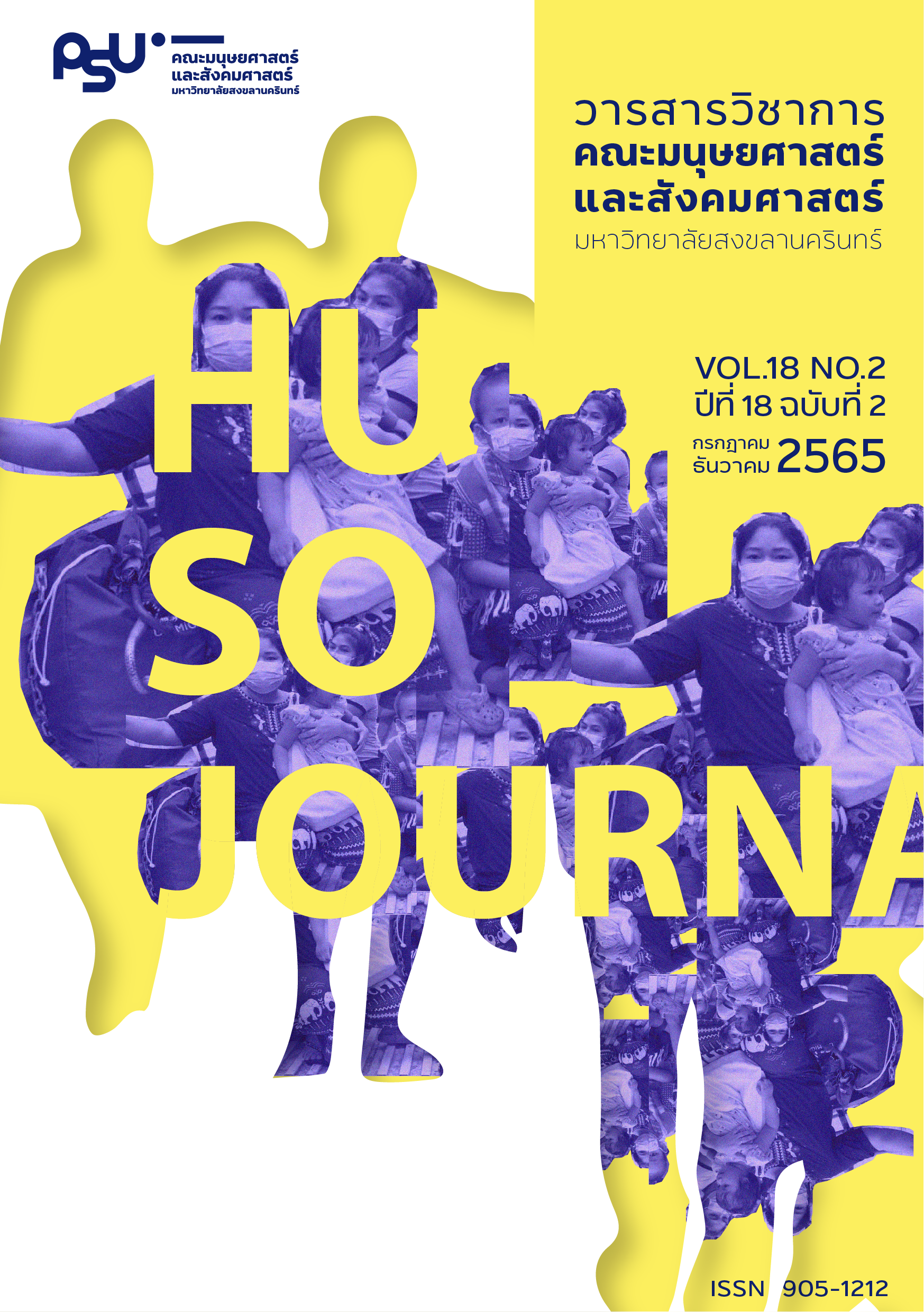Precarious Lives and Hope During a Pandemic Among Female Migrant Workers in Chiang Rai Province, Thailand
Keywords:
Hope, Precarious Lives, Female Migrant Worker, Chiang RaiAbstract
This article examines women migrant workers’ lives and experiences in Chiang Rai during the COVID-19 pandemic between 2020 and 2021, considering the conditions that shape women migrant workers’ precarious lives and their hope-generating process. According to the study, COVID-19 is not only a critical situation that leads women migrant workers to precariousness, but it becomes an actor who crosses over to work alongside other conditions such as socioeconomic structure, gender, and Thai bureaucracy to construct precarious lives. These conditions always interplay in women migrant workers’ daily lives but may be overlooked or not recognized until they come together to construct a state of being precarious and reveal the problem of its existence. However, women migrant workers have generated an infinite hope to cope with precariousness during a pandemic and create new opportunities to rearrange power relations in border areas, especially with the local disease control agencies. Furthermore, they also succeeded in changing migrant workers’ representation from being cheap labor to becoming an actor who plays an important role in epidemic control and prevention mechanisms in border towns.
References
เอกสารอ้างอิง
หนังสือและบทความวิชาการ
Abdul Azeez E P , Dandub Palzor Negi , Asha Rani & Senthil Kumar A P. (2020). The impact of COVID-19 on migrant women workers in India. Eurasian Geography and Economics. Retrieved 1 November 2020, from https://www.tandfonline.com/doi/full/10.1080/15387216.2020.1843513
Blanuša, J., Barzut, V., & Knežević, J. (2021). Intolerance of Uncertainty and Fear of COVID-19 Moderating Role in Relationship Between Job Insecurity and Work-Related Distress in the Republic of Serbia. Frontiers in psychology, 12, 647972. Retrieved 25 December 2021, fromhttps://doi.org/10.3389/fpsyg.2021.647972
Butler, J. (2004). Precarious Life: The Powers of Mourning and Violence. New York: Verso.
Bryant, R. & Knight, D. M. (2019). The Anthropology of the Future. New York: Cambridge University Press.
DuBose T. (2021). Dum Spiro Spero: On Post-Pandemic Hope. Human Arenas, 1–14. Advance online publication. Retrieved 25 December 2021, from https://doi.org/10.1007/s42087-020-00174-y
Högberg, K. (2021). Between hope and despair sensegiving and sensemaking in hotel organizations during the COVID-19 crisis. Journal of Hospitality and Tourism Management, Volume 49, 460-468. Retrieved 25 December 2021, from https://doi.org/10.1016/j.jhtm.2021.10.002
Hacimusalar, Y., Kahve, A. C., Yasar, A. B., & Aydin, M. S. (2020). Anxiety and hopelessness levels in COVID-19 pandemic: A comparative study of healthcare professionals and other community sample in Turkey. Journal of psychiatric research, 129, 181–188. Retrieved 25 December 2021, from https://doi.org/10.1016/j.jpsychires.2020.07.024
Jansen, S. (2018). The Anthropology of Hope. Oxford Research Encyclopedia of Anthropology. Retrieved 8 Aug. 2021, from https://oxfordre.com/anthropology/view/10.1093/acrefore/9780190854584.001.0001/acrefore-9780190854584-e-182.
Jiang, N., Yan-Li, S., Pamanee, K., & Sriyanto, J. (2021). Depression, Anxiety, and Stress During the COVID-19 Pandemic: Comparison Among Higher Education Students in Four Countries in the Asia-Pacific Region. Journal of Population and Social Studies. Retrieved 25 December 2021, from https://so03.tci-thaijo.org/index.php/jpss/article/view/244216/168568
Kallio, K.P., Meier, I. & Häkli, J (2020). Radical Hope in asylum seeking: political agency beyond linear temporality. Journal of Ethnic and Migration Studies. Retrieved 25 December 2021, from https://doi.org/10.1080/1369183X.2020.1764344
Khosravi, S. (2017). Precarious Lives: Waiting and Hope in Iran. Philadelphia: Pennsylvania University Press.
Nunn, C., Germaine, C., Ogden, C. et al. Precarious Hope: Situated Perspectives on the COVID-19 Pandemic from Undergraduate Students in Manchester, UK. JAYS (2021). Retrieved 25 December 2021, from https://doi.org/10.1007/s43151-021-00057-1
Foley, L. and Piper, N. (2020). COVID – 19 and women migrant workers: Impacts and implications in “think pieces” by IOM’s Migration Research High Level Advisers on the potential changes, impacts and implications for migration and mobility arising from COVID-19. Retrieved 25 December 2021, from https://publications.iom.int/system/files/pdf/covid19-and-women.pdf
Redlich Amirav, D., Besor, O., & Amirav, I. (2021). Hope During COVID-19 Lockdown. Cureus, 13(5), e15097. Retrieved 27 December 2021, from https://doi.org/10.7759/cureus.15097
Rotter, R. (2016). Waiting in the asylum determination process: Just an empty interlude? Time & Society, 25(1), 80–101. Retrieved 27 December 2021, from https://doi.org/10.1177/0961463X15613654
Scott, J. C. (1985). Weapons of the weak: Everyday forms of peasant resistance. New Haven: Yale University Press.
Suresh, R., James, J., & R S J, B. (2020). Migrant Workers at Crossroads-The Covid-19 Pandemic and the Migrant Experience in India. Social work in public health, 35(7), 633–643. Retrieved 27 December 2021, from https://doi.org/10.1080/19371918.2020.1808552
Zhao X. (2021). Experiencing the Pandemic: Narrative Reflection about Two Coronavirus Outbreaks. Health communication, 36(14), 1852–1855. Retrieved 27 December 2021, from https://doi.org/10.1080/10410236.2020.1800277
รายงานองค์กรและข่าวที่เผยแพร่บนอินเทอร์เน็ต
BBC Thai. (2020, 20 November). In Japan, more people died from suicide last month than from Covid in all of 2020. And women have been impacted most. Retrieved 10 December 2021, from https://edition.cnn.com/2020/11/28/asia/japan-suicide-women-covid-dst-intl-hnk/index.html
MAP Foundation. (2560). ความฝันอันไม่อาจเอื้อมถึง: ค่าจ้างเพื่อชีวิตสำหรับแรงงานข้ามชาติหญิงในประเทศไทย. สืบค้น 19 พฤศจิกายน 2563, จาก http://apwld.org/wp-content/uploads/2018/02/2018_BOOM-FPAR-MAP-Country-briefer-TH-1.pdf
TCIJ. (2563, 21 กรกฎาคม). เสียงสะท้อนของหญิงแรงงานข้ามชาติในไทยจากสถานการณ์โควิด 19. สืบค้น 19 พฤศจิกายน 2563, จาก https://www.tcijthai.com/news/2020/7/article/10693
ThaiPBS. (2564, 25 พฤศจิกายน). พิษโควิดบีบคนไทยเครียด ยอดฆ่าตัวตายพุ่ง ปี 63. สืบค้น 5 ธันวาคม 2564, จาก https://news.thaipbs.or.th/content/310061
Workpoint Today. (2564, 18 ธันวาคม). ‘ไฟเซอร์’ คาดโควิดจบปี 2567 เปลี่ยนจากโรคระบาดเป็นโรคประจำถิ่น. สืบค้น 19 ธันวาคม 2564, จาก https://workpointtoday.com/covid-pfizer-2024/
การสัมภาษณ์
ตัวแทนศูนย์ประสานงานช่วยเหลือแรงงานข้ามชาติ. (2564, พฤศจิกายน). สัมภาษณ์.
นา (นามสมมติ). (2564, 16 กรกฎาคม). สัมภาษณ์.
นุช (นามสมมติ). (2564, 16 กรกฎาคม). สัมภาษณ์.
น้อย (นามสมมติ). (2564, 5 มิถุนายน). สัมภาษณ์.
มิน (นามสมมติ). (2563, 20 พฤษภาคม). สัมภาษณ์.
เม (นามสมมติ). (2563, 27 พฤษภาคม). สัมภาษณ์.
เหมียว (นามสมมติ). (2563, 1 พฤษภาคม). สัมภาษณ์.
เอม (นามสมมติ). (2563, 20 มิถุนายน). สัมภาษณ์.
อ้อม (นามสมมติ). (2564, 29 พฤศจิกายน). สัมภาษณ์
Downloads
Published
How to Cite
Issue
Section
License
Copyright (c) 2022 Journal of Humanities and Social Sciences Prince of Songkla University

This work is licensed under a Creative Commons Attribution-NonCommercial-NoDerivatives 4.0 International License.
บทความนี้ได้รับการตีพิมพ์เป็นของวารสารวิชาการคณะมนุษยศาสตร์และสังคมศาสตร์ คณะมนุษยศาสตร์และสังคมศาสตร์ มหาวิทยาลัยสงขลานครินทร์ วิทยาเขตปัตตานี






